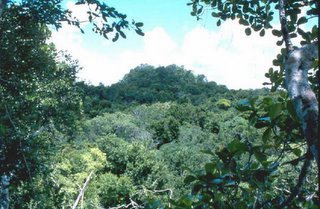To round off our explorations of the ancient Mayan empire, we decided to undertake a jungle trek to El Mirador, buried deep beneath the thick lowland jungles of the Peten department of Guatemala. This seemed like a logical choice for our final Mayan hurrah, since it contains the oldest Mayan ruin ever unearthed, the highest Mayan pyramid ever built and the largest of all the cities – the Big Smoke of the Mayan Empire.Enshrouded in mystery, much of El Mirador lies under forest cover while researchers, scientists and conservationists work hard to protect it from slash and burn agriculture and logging companies. Last spring, Mel Gibson visited the site in support of the campaign to conserve the surrounding forest for his upcoming film project, Apocalypto. He flew to El Mirador in a helicopter. We hiked 148 km with a pack mule.
(Google Earth... from approx. - 17º15’15.97” N, 90º00.23.07” W, to approx. 17º47’44.03” N, 90º04.24.05” W)Last spring, Kieran and I decided to go on a road trip in southern Mexico. We flew from Havana to Cancun and rented a car, driving from Quintana Roo, through Campeche to Chiapas and back in two weeks covering a total of 3,400 km and visiting the Mayan sites of Calakmul, Yaxchilan, Palenque, Uxmal and Chichen Itza. Each of these well-excavated sites was interesting in its own way - some for the detail in their restoration and some for their natural setting.
What we know about the Mayans is based on educated guesses – it’s hard to put a whole civilization into context, especially given that they lived more than a thousand years ago. What we know for sure is that Mayans really liked to build things out of rocks – the higher the better. They had no metal and there is no record that they had invented the wheel, so they must have been pretty strong. The fact that they were an advanced society yet a Stone Age people makes their work that much more impressive.
We know that Mayans played a ball game. Whether it was a spectator sport or a ritual no one can be sure, but it ultimately ended in somebody dying, most likely the loser. The Mayan people were big on animal symbols – jaguars and serpents were clearly worshiped while turkeys and deer were offered as sacrifices. As were people.
While visiting these well-restored ruins in Mexico and more recently in Tikal, Guatemala, we wondered how anyone would be able to accurately pinpoint where to look in the thick of the jungle. After all, a ruin is nothing more than a mound of rocks buried and broken up by tree roots until it is discovered by either tomb raiders – tunnelled into and plundered, or archaeologists – unearthed and restored.
On the first day of our El Mirador jungle trek, we stopped at a hill no more than eight feet high. Oswaldo, a former chiclero turned trekking guide, told us it was a Mayan ruin. As he made his way around the back of the hill to an opening that had been carved out, he told us that looters had discovered it - we could go inside if we wanted to but all the treasures were already long gone.
Although unimpressive as ruins go, it was the first time I was able to see the signs. The surrounding area was flat, broken by two irregular bumps in the earth. The rocks protruding from the ground had squared-off edges and were white rather than the earthy brown colour typical to the region. As we walked on, we realized that we were trampling over vast expanses of buried city. Every odd-shaped hill we walked up was yet another temple, monument or acropolis buried under a mess of dirt, trees, shrubs and vines.
A family of curious spider monkeys greeted us on arrival at the first camp. They circled the site shaking branches until sundown, as entertained by us as we were by them.
The next day around lunch-time we arrived at El Mirador, welcomed by the three lonely guards who live at the site for several weeks at a time. They were happy to have company and set about showing us a collection of ancient Mayan pottery that they themselves had acquired.
Had we never seen Mayan ruins, it would have been largely unimpressive. Even at the base of the largest pyramid, it is hard to see that there is anything there. The natural setting alone would have made the trip worthwhile, but we would have had little frame of reference for understanding the magnitude of what was beneath our feet. The El Tigre complex, the largest pyramid ever built, is supposed to have looked like this :
Here’s how it appears today:
As we watched the sun set from the top of El Tigre, the calls of the toucans and parrots in the trees below mingled with the sound of howler monkeys in the distance. Low-lying jungle stretched as far as the eye could see, dotted with large mounds, which, like El Tigre, are the many other pyramids waiting to be uncovered. All of this is evidence that an advanced society just disappeared – absorbed back into the jungle by some tragic flaw in the way they lived – most likely an unsustainable use of resources. Some researchers believe they poisoned their water supply and others believe they used up too many of the forest’s timber. Perhaps both simultaneously? It is ironic that before we ever know for sure, our own advanced society may have met the same fate.
We spent a day and a half exploring the ruins, chasing monkeys, watching birds and looking for the elusive jaguar, which remained elusive.
When we set out to hike back on the fourth day of our five day expedition, we got it in our heads that we should walk the entire 74 km in one day, partly to get to Belize a bit faster, but mostly because we needed a proper shower. And so we hiked through jungle in the hot sun and then the rain for eleven and a half hours, stopping once for a snack and once for a sandwich, alternating between riding that pack mule and walking on foot.We’ve decided that we are all ruined out, so we are headed for the sunny coast and barrier reef of Belize, hoping to sail from Caye Caulker to Placencia. Time is running out so we have to move fast...
Saturday, March 04, 2006
Ruined!
Subscribe to:
Post Comments (Atom)


4 comments:
Pretty! This has been a really wonderful article. Thanks for providing this info.
Here is my website ... golf digest subscription Service
hello!,I like your writing so much! share we be in contact more about your post
on AOL? I need a specialist in this space to unravel my problem.
Maybe that is you! Taking a look forward to look you.
Feel free to visit my website :: public golf courses in kissimmee
Hey are using Wordpress for your site platform?
I'm new to the blog world but I'm trying to get started and create
my own. Do you require any html coding knowledge to make your own blog?
Any help would be greatly appreciated!
Review my web site - golf club sets reviews 2012
WOW just what I was looking for. Came here by searching for golf courses 2013 calendar
Also visit my blog: willowsgolfresort.com
Post a Comment